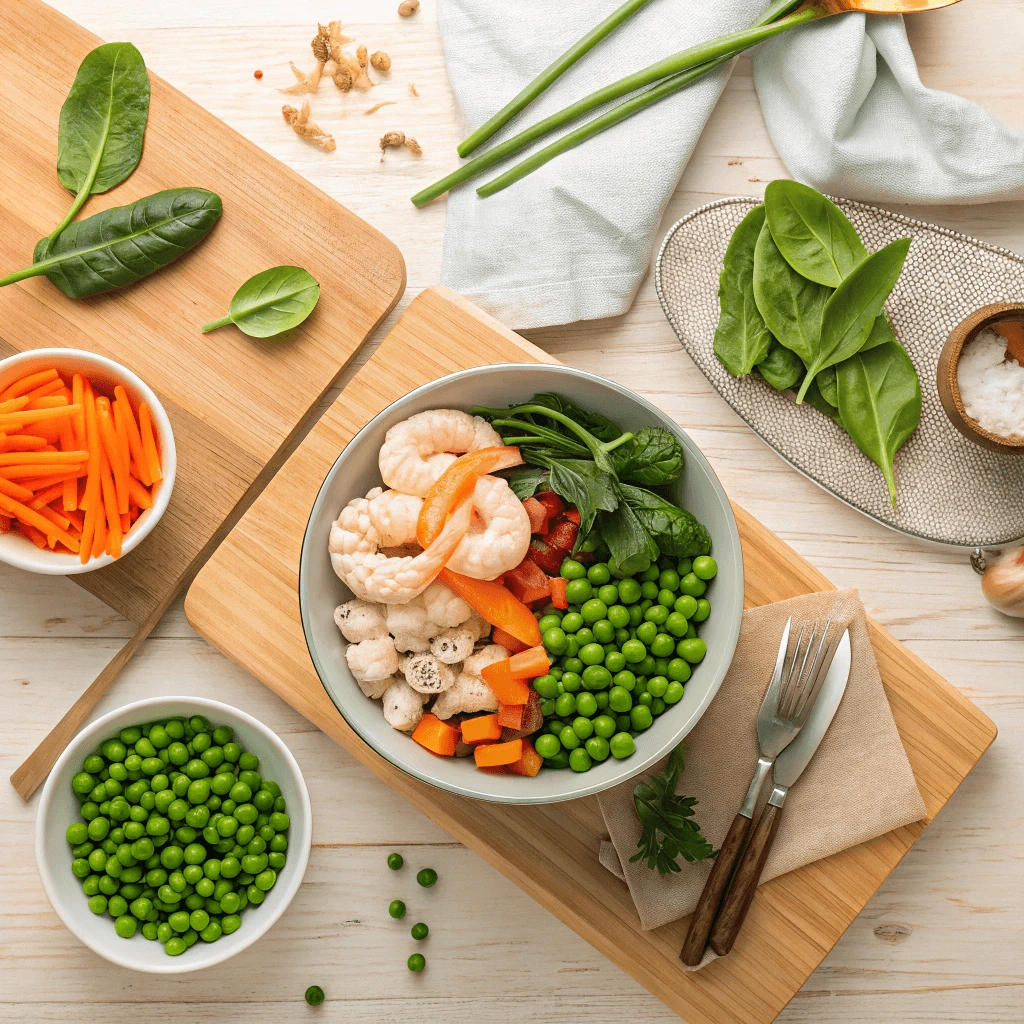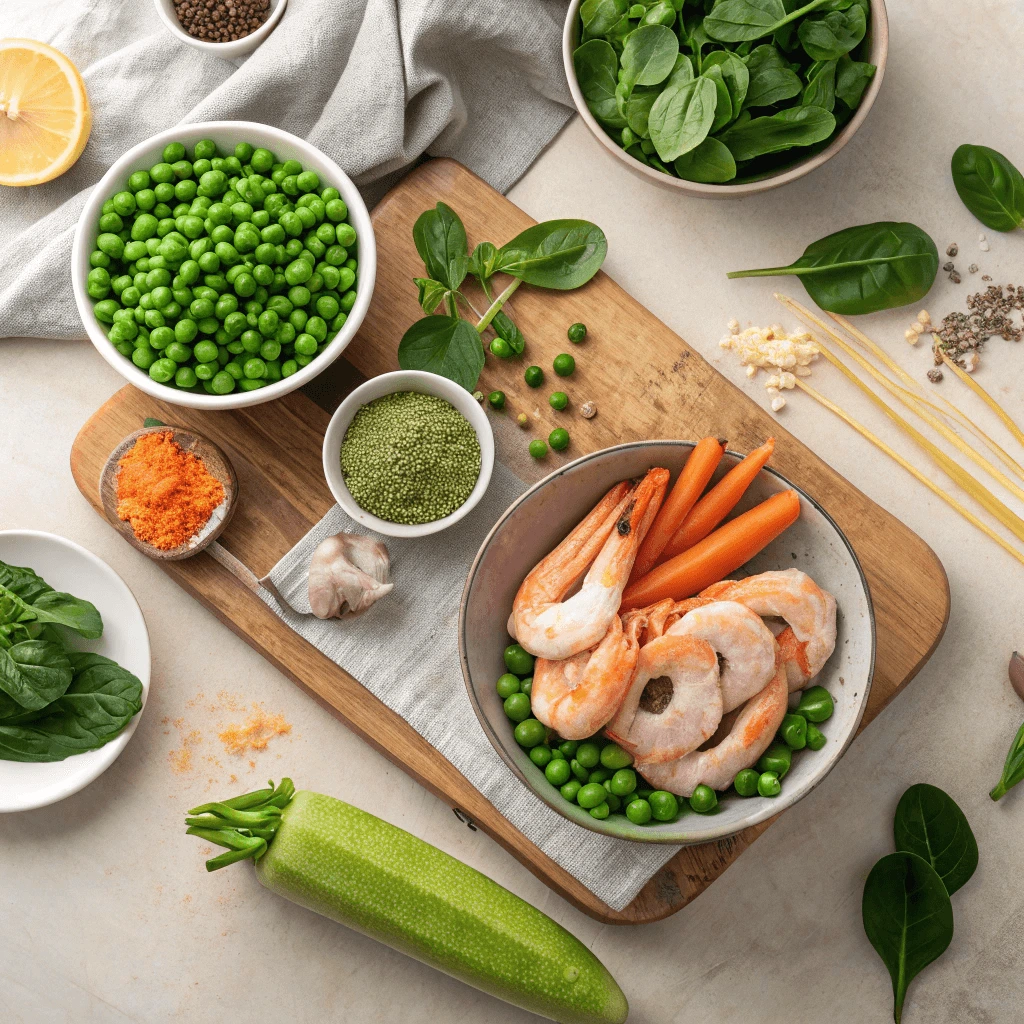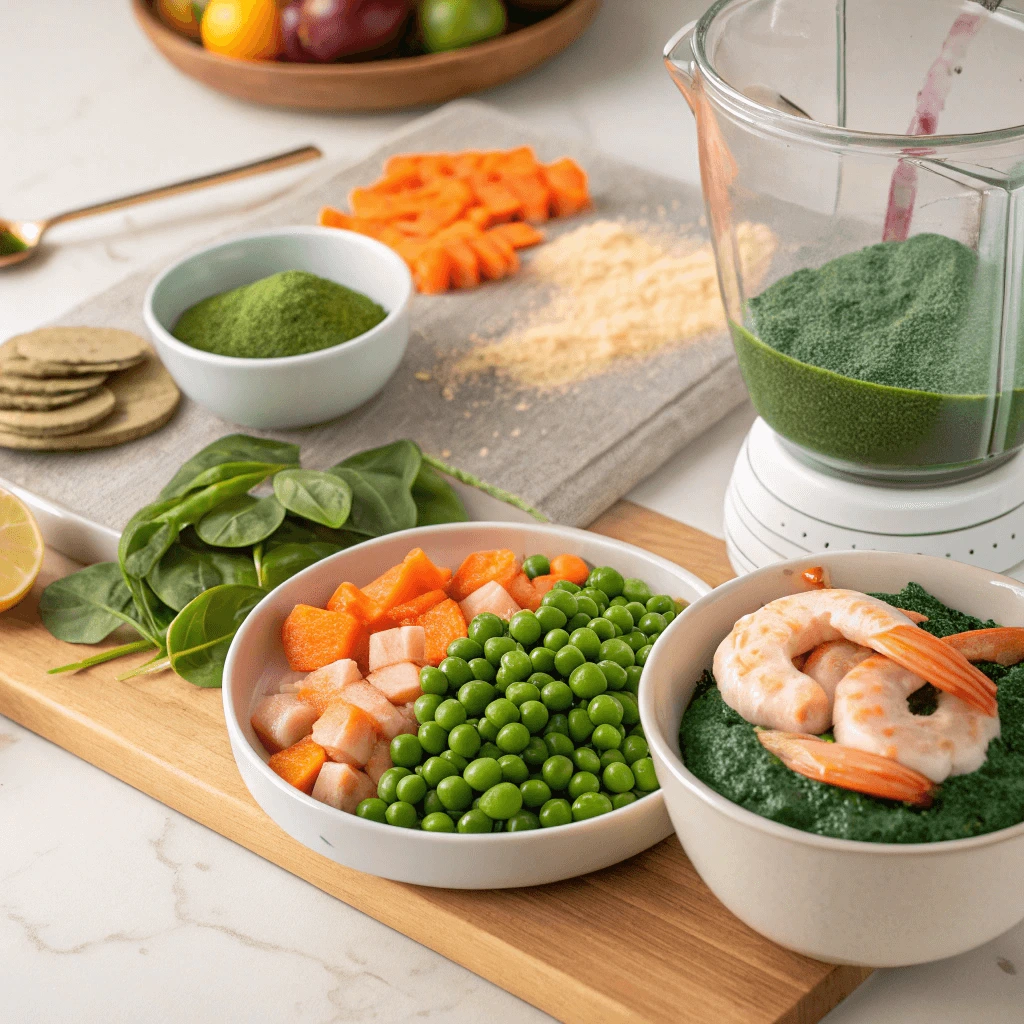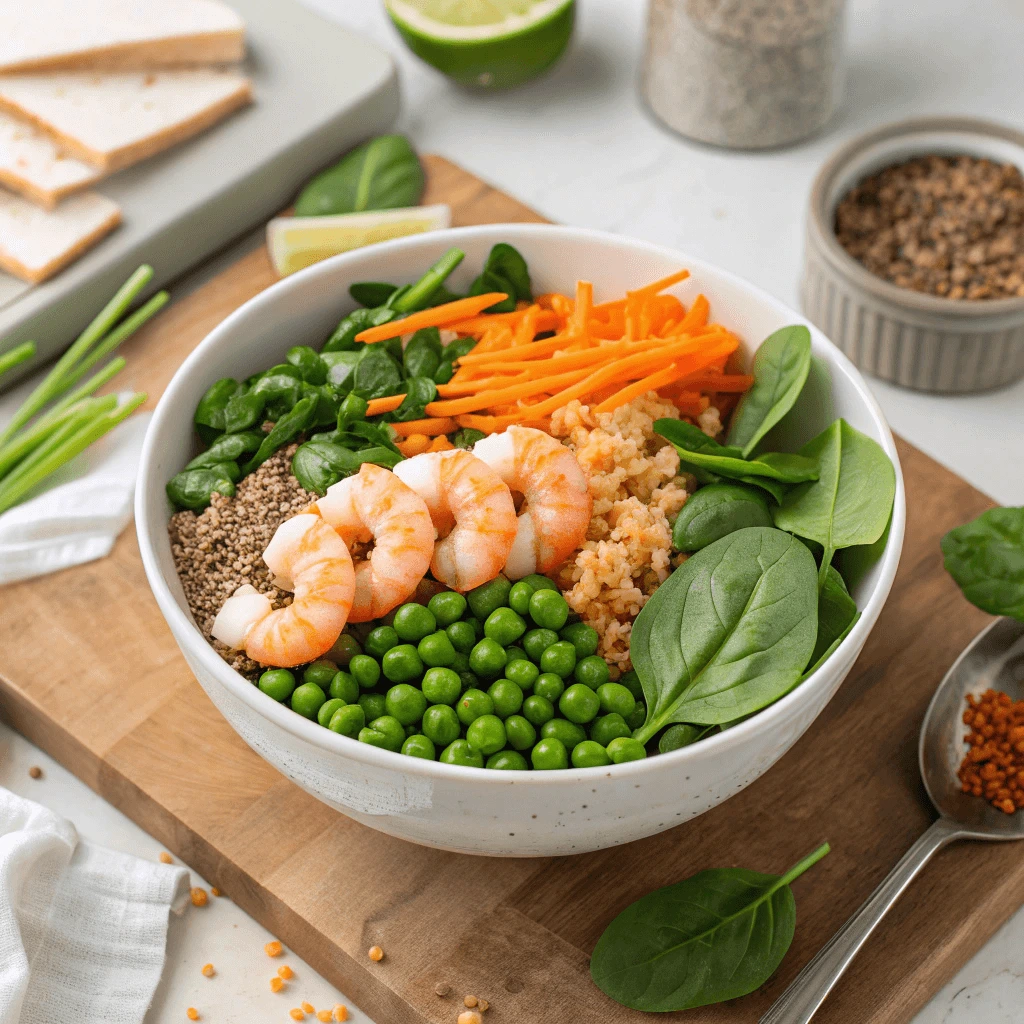Tropical fish thrive on a diet that’s rich in nutrients and tailored to their specific needs. That’s why creating the ultimate fish food recipe for tropical fish at home can make a big difference in their health and vibrancy. Unlike store-bought options, a homemade fish food recipe lets you control the ingredients—adding high-quality protein, natural fiber, and essential vitamins. In this guide, you’ll discover a DIY recipe that’s simple to make, cost-effective, and perfect for keeping your tropical fish active and colorful.
Why Nutrition Matters for Tropical Fish

The Role of Proper Diet in Fish Health
A proper diet is essential for the health and well-being of tropical fish. Just like humans, fish need a balanced diet to grow, stay active, and fight off diseases.
Essential Nutrients for Tropical Fish
Tropical fish need a mix of proteins, fats, vitamins, and minerals. Protein supports muscle growth and energy, while fats provide energy storage. Vitamins and minerals help with functions like immune support and bone development. A balanced diet ensures vibrant colors and healthy growth in your fish.
Consequences of Poor Diet
A poor diet can lead to health issues like stunted growth, weak immune systems, and dull colors. Fish that lack the proper nutrients are more prone to diseases and infections. An unbalanced diet can also result in obesity or other conditions that harm their long-term health.
Benefits of Homemade Fish Food
Homemade fish food allows you to control the ingredients, ensuring that your fish get the best nutrients without additives or preservatives. With the right ingredients, you can boost your fish’s vitality and overall health, helping them live longer, happier lives.
Common Nutritional Deficiencies in Tropical Fish
Tropical fish need a balanced diet to thrive. Without the proper nutrients, they can develop several health problems. Here are some common nutritional deficiencies and how they affect fish:
Protein Deficiency
Protein is essential for growth, muscle development, and overall health. Without enough protein, tropical fish may show signs of stunted growth, weakened immune systems, and poor color. To avoid this, include high-quality protein sources like shrimp or spirulina in their diet.
Vitamin and Mineral Deficiencies
Vitamins and minerals, such as vitamin A and vitamin C, are necessary for immune function and overall health. Deficiencies can lead to poor coloration, weakened immunity, and slow growth. Minerals like calcium and phosphorus are also important for bone development. A well-rounded fish food recipe should address these gaps.
Fatty Acid Imbalance
Fish need the right balance of fats, especially Omega-3 and Omega-6 fatty acids, for energy and healthy skin. Too much fat can cause obesity, while too little can lead to sluggishness and reproductive issues. A proper balance of fatty acids helps maintain fish vitality.
Tailoring Fish Food to Different Tropical Species
Each species of tropical fish has unique dietary needs based on their natural habitat, size, and feeding behavior. By tailoring their food to meet these specific needs, you can ensure they thrive and stay healthy. Here’s a closer look at how to customize your tropical fish food for different species:
Herbivorous Tropical Fish
Herbivorous fish, such as certain species of tangs and angelfish, primarily feed on algae, plants, and other plant-based foods. These fish need a diet that is rich in fiber and essential plant nutrients. When preparing food for these fish, consider adding ingredients like spinach, kale, and spirulina. These ingredients mimic the algae and plant matter they would encounter in the wild, helping to keep them healthy and satisfied.
Carnivorous Tropical Fish
Carnivorous fish, like bettas, puffers, and larger species like Oscars, thrive on a diet rich in protein. These fish need foods that are high in animal-based protein to support muscle growth and energy levels. Shrimp, fish fillets, and squid are excellent protein sources. Be sure to blend the ingredients well to create a balanced, easy-to-digest food for these species.
Omnivorous Tropical Fish
Omnivorous species, like gouramis and mollies, eat both plant and animal-based food. To meet their dietary needs, a balanced mix of plant matter, such as blanched vegetables, and high-quality protein sources, like shrimp and fish meal, is ideal. Offering a variety of food options ensures they get the right nutrients for growth, color, and overall vitality.
Key Ingredients for a Balanced Tropical Fish Diet

High-Quality Protein Sources for Tropical Fish
Protein is essential for the growth, energy, and overall health of tropical fish. Providing them with high-quality protein ensures they develop strong muscles and maintain a healthy immune system. Let’s take a look at some of the best protein sources for tropical fish.
1. Shrimp
Shrimp is a rich source of easily digestible protein and fatty acids. It promotes muscle growth and supports the immune system. Shrimp is particularly beneficial for carnivorous species, like bettas. You can chop or blend shrimp to make it easier for your fish to eat.
2. Fish Fillets
Fish fillets, especially from smaller fish like sardines or anchovies, are packed with protein and omega-3 fatty acids. Omega-3s improve heart health and enhance color. These fillets are ideal for omnivorous and herbivorous fish that need a balanced diet.
3. Squid and Shellfish
Squid and other shellfish, such as mussels, provide high protein content and essential nutrients. These are great for carnivorous fish like puffers. Chop squid into small pieces to make it easy for your fish to consume.
Natural Fiber for Digestion in Tropical Fish
Just like humans, tropical fish require a diet that includes fiber to aid in digestion and promote overall gut health. Natural fiber helps fish process food more efficiently, prevents constipation, and supports their ability to absorb nutrients. Here are some of the best natural fiber sources to include in your fish food recipes.
1. Vegetables
Certain vegetables are high in fiber and can be a great addition to your fish’s diet. Vegetables like spinach, peas, and zucchini are particularly beneficial. These foods are high in fiber, which helps maintain healthy digestion in tropical fish. Peas, for instance, are excellent for keeping the digestive system running smoothly by preventing bloating or constipation, which can lead to other health issues.
To make these vegetables more digestible for your fish, blanch them before adding them to your homemade fish food. This method softens the veggies, making them easier for your fish to consume. Spinach and zucchini, when finely chopped or pureed, offer fiber while being gentle on the digestive system.
2. Seaweed
Seaweed is another fiber-rich food that tropical fish love. It is not only an excellent source of fiber but also provides essential vitamins and minerals like iodine, which supports thyroid function. Different types of seaweed, such as nori or spirulina, can be added to your fish food recipe to boost fiber content while providing your fish with additional nutrients that promote healthy digestion and vibrant color.
Many herbivorous fish, such as algae eaters or certain species of catfish, thrive on a diet high in fiber from seaweed. By adding it to their food mix, you are simulating their natural diet and helping to enhance their digestion.
3. Fiber-Rich Grains
Certain grains, like oats, are another great source of fiber for tropical fish. Oats can help regulate digestion and ensure that food moves through the digestive tract properly. These grains also provide a slow-releasing source of energy, which keeps your fish active throughout the day.
Oats can be ground into a fine powder or mixed with other ingredients in your fish food recipe to provide additional texture. When incorporated with other protein-rich foods like fish fillets or shrimp, oats create a well-rounded meal that supports both digestion and muscle health.
Incorporating these natural fiber sources into your tropical fish food will help them maintain a healthy gut and prevent common digestive issues. A balanced fiber intake ensures that their food is properly processed, absorbed, and utilized for maximum health benefits.
Vital Vitamins and Minerals for Tropical Fish Health
A healthy diet for tropical fish goes beyond protein and fiber—vitamins and minerals are crucial for their growth, immune function, and overall well-being. Let’s explore some key vitamins and minerals, their importance, and how you can incorporate them into your homemade fish food.
1. Vitamin A
Vitamin A is essential for healthy vision, immune function, and skin health. It helps maintain vibrant colors in fish and supports their mucous membranes to protect against infections. You can include Vitamin A in your fish food using ingredients like carrots and spinach, which are rich in beta-carotene.
2. Vitamin C
Vitamin C is an antioxidant that boosts immune health and aids in collagen production, which supports tissue and skin health. It also helps with iron absorption. Add citrus fruits, bell peppers, or leafy greens to your recipe to ensure your fish get enough Vitamin C.
3. Vitamin D
Vitamin D helps with calcium and phosphorus absorption, ensuring strong bones and scales. It also regulates calcium levels, preventing bone-related issues. You can add fish oils or egg yolks to your fish food to provide sufficient Vitamin D.
4. Calcium and Magnesium
These minerals are vital for bone health, muscle function, and enzyme activation. Calcium supports strong bones and scales, while magnesium helps muscle function. Add crushed coral, eggshells, or leafy greens to provide these essential minerals.
5. Iron
Iron is necessary for oxygen transport in the bloodstream. It supports healthy growth and helps prevent anemia. You can include spinach, peas, and liver in your homemade fish food for an excellent iron source.
How to Make the Ultimate Tropical Fish Food Recipe

Preparing the Ingredients for Tropical Fish Food
Proper preparation of ingredients is essential to ensure that your homemade tropical fish food is both nutritious and digestible. Here’s a breakdown of the preparation process for each ingredient.
1. Cleaning and Prepping Fresh Ingredients
Start by cleaning all fresh ingredients like vegetables, shrimp, and fish. Wash vegetables like spinach and peas thoroughly to remove dirt and chemicals. For shrimp and fish, rinse them under cool water to eliminate impurities. Ensure that fish is free from bones, and remove the shells from shrimp.
2. Cooking and Steaming Vegetables
Certain vegetables, like peas and spinach, should be lightly steamed to make them more digestible. This process also ensures that any harmful bacteria are removed. Steam them for just a few minutes to retain their nutrients.
3. Preparing Protein Sources
For proteins like shrimp and fish fillets, peel shrimp and debone the fish. Boil eggs and discard the shells or crush them for calcium. Properly prepare these protein sources by chopping them into smaller pieces or blending them for easier consumption by your fish.
4. Blending and Mixing
After preparing all your ingredients, blend them into a smooth paste. A blender or food processor will help achieve an even consistency. This will make it easier for the fish to eat and ensure a balanced distribution of nutrients.
5. Adding Supplements
Consider adding supplements like spirulina powder or fish oil to boost the nutritional value of your food. These additions can support the fish’s immune system and overall health.
Mixing the Fish Food Base
Mixing the fish food base properly ensures that all the nutrients are evenly distributed, making the food effective for your tropical fish. Here’s a simple guide to get the right consistency and nutrient balance.
1. Select Your Mixing Tools
A blender or food processor is ideal for blending the ingredients into a smooth, consistent paste. These tools help mix proteins, vegetables, and supplements evenly, ensuring a balanced meal.
2. Add Ingredients Gradually
Start by adding proteins like shrimp or fish fillets, blending them until smooth. Then, add vegetables like peas or spinach and blend again. This method helps each ingredient blend in thoroughly.
3. Incorporate Supplements
Once your main ingredients are mixed, add supplements like spirulina or fish oil. These boost the nutritional content and make the food more beneficial for your fish.
4. Adjust Consistency
If the mixture is too thick, add a little water or fish broth. If it’s too thin, gelatin can help firm it up. Aim for a consistency that holds together but isn’t too dry.
5. Test the Mixture
Before finalizing, test the mixture by refrigerating a small amount. If it holds well after cooling, you’re ready to move on to shaping or storing the food.
Setting and Freezing for Long-Term Use
After mixing your fish food base, freezing it is the best way to store it for future use. Freezing preserves the food’s nutrients and ensures it stays fresh. Here’s a simple guide to properly set and freeze your fish food:
1. Choose the Right Storage Containers
Opt for airtight containers, silicone molds, or ice cube trays to hold the fish food mixture. This helps keep the food secure and prevents contamination during freezing.
2. Portion the Fish Food
Portion out the mixture into small, manageable servings. Ice cube trays are a great option, as each cube is a single serving. This makes feeding more convenient, as you can thaw exactly what you need.
3. Flatten and Freeze
For bulk storage, spread the food evenly in containers or on baking sheets. Flatten it out to ensure even freezing. Place it in the freezer for several hours or overnight until solid.
4. Store for Long-Term Use
Once frozen, transfer the portions to freezer bags or airtight containers for easy access later. Label them with the date of freezing to help keep track of freshness.
5. Thawing the Fish Food
When ready to feed, remove a portion and let it thaw in the fridge or in a bowl of water. Only thaw what you plan to use to maintain freshness.
Freezing your fish food ensures that it remains nutritious and easy to serve for an extended period. This method is convenient, saves time, and allows you to always have high-quality food on hand for your tropical fish.
Benefits of Homemade Tropical Fish Food
Healthier Fish with Homemade Food
Feeding your tropical fish homemade food doesn’t just save money—it plays a key role in promoting their overall health and well-being. By choosing fresh, high-quality ingredients and customizing the diet, you can directly influence the vitality and longevity of your fish.
Boosts Immune Function
Homemade fish food allows you to include immunity-boosting ingredients like garlic, spinach, and vitamin-rich supplements. These nutrients help fish resist common illnesses such as ich or fin rot. Instead of relying on mass-produced flakes with limited nutrition, you give your fish the tools to stay strong and fight off disease naturally.
Improves Color and Energy
When you feed your fish natural pigments like spirulina, carrots, or krill, you enhance their natural coloration. Bright, vibrant colors are often a sign of good health in tropical species. A well-balanced homemade diet also supplies energy for daily activity, helping fish swim actively and engage with their environment.
Supports Digestive Health
With homemade food, you control fiber content by including ingredients like peas, seaweed, or zucchini. These promote healthy digestion and reduce the risk of constipation or bloating, which is especially important for species like bettas and goldfish.
Cost-Effective Alternative to Commercial Fish Food
Switching to homemade fish food not only gives you control over ingredients but also reduces your expenses significantly. With just a few kitchen staples, you can feed your tropical fish nutritiously and affordably.
Save Money with Bulk Ingredients
Buying ingredients like peas, gelatin, spinach, shrimp, and fish fillets in bulk allows you to make large batches of food at a fraction of the cost of store-bought flakes or pellets. These ingredients often cost less per serving and stretch further, especially when frozen and portioned correctly.
Reduce Waste and Packaging
Homemade fish food helps reduce packaging waste. Instead of repeatedly buying small plastic containers or foil bags, you can store your food in reusable containers or silicone trays. This approach supports a more eco-friendly fishkeeping routine while saving on packaging-related costs.
Customize Based on Budget
You can adjust your homemade recipe based on your budget. For example, if shrimp is expensive, substitute it with boiled egg or white fish. If fresh greens aren’t available, frozen ones work just as well. This flexibility lets you maintain nutritional quality without overspending.
Customization Based on Species Needs
Each tropical fish species has unique dietary requirements. When you make homemade fish food, you can tailor the ingredients and texture to meet those specific needs, ensuring your fish stay healthy and thrive.
Understand Your Fish’s Natural Diet
Start by researching what your fish eat in the wild. Herbivorous fish like Mollies and Plecos benefit from a plant-rich diet full of spinach, peas, and zucchini. Carnivorous species such as Bettas and Oscars require high levels of protein from sources like shrimp, fish fillets, and eggs. Omnivorous fish need a balance of both.
Adjust Texture and Size
Small-mouthed fish such as Neon Tetras need finely blended or crumbled food to eat easily, while larger species like Angelfish or Gouramis can handle thicker gels or chunkier pieces. You can easily modify the consistency during blending and mold the food into appropriate shapes or sizes before freezing.
Vary Ingredients for Better Results
Fish can get bored with repetitive meals, just like humans. By rotating ingredients—such as using spinach one week and seaweed the next—you provide a broader range of nutrients and improve appetite. This variety also helps mimic the diversity of their natural feeding habits.
Additional Tips for Feeding Tropical Fish
Feeding Frequency for Optimal Health
Maintaining the right feeding schedule plays a vital role in your tropical fish’s health, growth, and water quality. Overfeeding or underfeeding can both lead to serious problems, but finding the right balance ensures your fish stay vibrant and active.
Understand Species-Specific Needs
Different tropical fish species have varying metabolism rates. For example, active fish like Guppies and Tetras often need small meals two to three times per day to support their energy levels. On the other hand, slower-moving fish like Bettas or Catfish may only require feeding once daily. Always observe your fish’s behavior and adjust accordingly.
Focus on Portion Control
Feed only what your fish can consume within two to three minutes. Excess food settles at the bottom, leading to water pollution and harmful bacteria buildup. A good rule of thumb is to offer smaller amounts more frequently rather than a large feeding all at once.
Adjust Frequency for Life Stages and Conditions
Young or growing fish typically need more frequent feedings to fuel their development. In contrast, adult fish require less food, and feeding them too often can cause obesity and stress. During breeding or after illness, you can increase feedings with nutrient-dense options to help recovery—but always return to a balanced schedule.
How to Introduce Homemade Food to Your Fish
Switching to homemade fish food offers many benefits, but sudden changes can surprise or stress your fish. A careful, gradual approach helps them accept new food while allowing you to monitor their response and ensure nutritional success.
Start with Small Portions
Begin by offering a tiny amount of homemade food alongside their usual commercial diet. This gives your fish a chance to taste and explore the new food without feeling forced to eat it. If they ignore it at first, don’t worry—many fish need a few attempts before accepting something new.
Observe Behavior Closely
Watch how your fish react to the homemade food. Do they nibble and swim away, or do they eat eagerly? Pay attention to any leftovers, as uneaten food may foul the water. If the fish seem interested but hesitant, try adjusting the texture, size, or how the food floats or sinks.
Transition Gradually Over Days
Slowly increase the proportion of homemade food over a week or two. For example, replace 25% of one feeding with homemade food, then 50% the next day, and so on. This gradual transition lets their digestive systems adjust and gives you time to tweak the recipe if needed.
Ensuring Proper Storage of Fish Food
Homemade fish food, like any fresh or perishable item, requires correct storage to maintain its nutritional quality and prevent spoilage. Without proper handling, the food can degrade quickly, leading to nutrient loss or even harm to your fish. Let’s explore how to store it safely and effectively.
Use Airtight Containers
After preparing your DIY fish food, transfer it immediately into airtight containers. These containers prevent moisture and air from breaking down vitamins and proteins. Use BPA-free plastic, silicone molds, or small glass jars for convenient portioning.
Refrigerate or Freeze for Longevity
If you plan to use the food within 2–3 days, store it in the refrigerator. For longer storage, freezing is best. Freeze your food in thin sheets or cubes for easy access, and label containers with preparation dates to keep track. Most frozen homemade fish food stays fresh for up to one month.
Avoid Cross-Contamination
Always use clean utensils when handling fish food. Never refreeze thawed portions, as this can introduce bacteria. Also, store the food separately from human food in your freezer to avoid odor or flavor transfer.
Conclusion
Making your own nutrient-rich fish food offers tropical fish a healthier, more natural diet while saving money. By using quality ingredients tailored to your fish’s needs, you promote better digestion, brighter colors, and increased energy. Don’t be afraid to experiment with the recipe—observe how your fish respond and make adjustments for the best results. Each species may have unique preferences, so fine-tuning their diet can lead to happier, longer-living pets. With a little effort and care, homemade fish food can truly transform your aquarium’s health and vitality.
